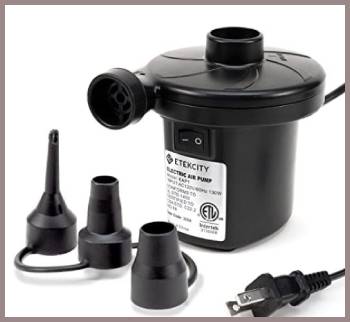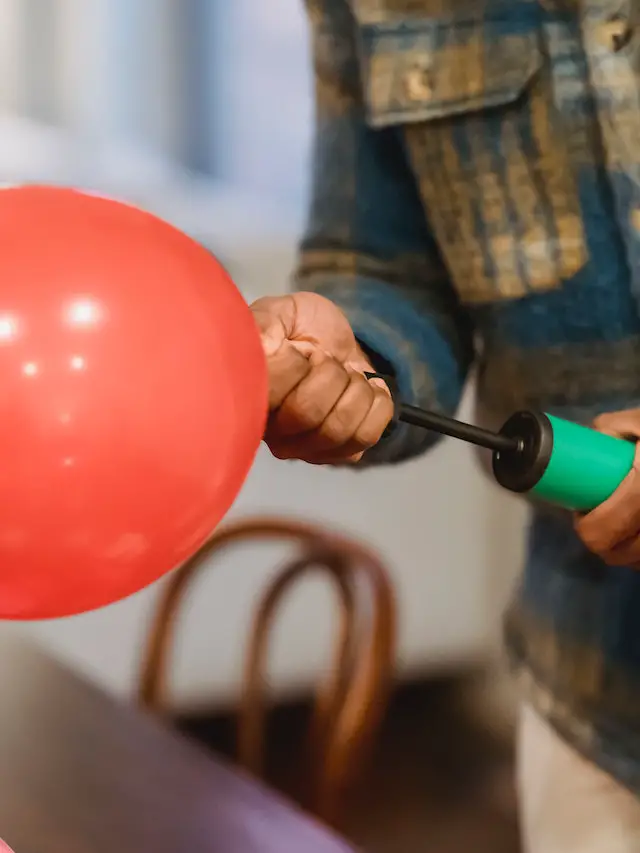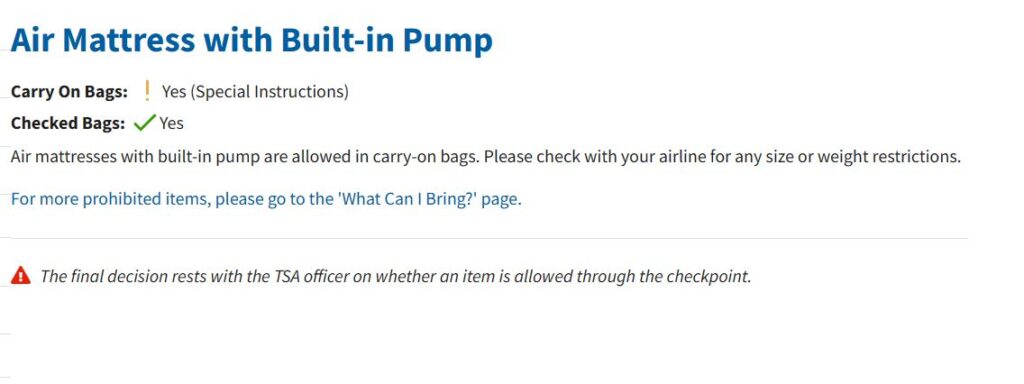When planning your next adventure, you might find yourself needing to pack an air pump for inflating items like air mattresses, pool floats, or bike tires at your destination. But wait, “Can I bring an air pump on a plane?” you wonder.
In this comprehensive guide, we’ll explore the ins and outs of taking air pumps, tire inflators, and small air compressors on an airplane.
Table of Contents
It All Starts with Airline Regulations
Before you even think about packing that air pump, you should consider airline regulations. Each airline has its specific rules regarding what items you can and cannot bring on a plane. Air pumps, tire inflators, and small air compressors fall under the umbrella of “tools,” and while some airlines may allow them, others may not. To be on the safe side, always check with your airline for their specific guidelines.
Air Pumps in Carry-Ons: Yes or No?
Air pumps come in various shapes and sizes, ranging from small hand-operated models to larger electric-powered units. So, can you bring an air pump in your carry-on luggage? The short answer is yes, but with some caveats.
TSA (Transportation Security Administration) rules in the United States permit passengers to carry on most types of air pumps, provided they meet size and weight requirements. However, this is subject to the airline’s discretion, so always double-check before packing your air pump.
Electric air pumps are generally allowed in carry-on bags, but you must follow the guidelines regarding battery-operated devices. For example, the lithium-ion batteries in these pumps must be under 100 watt-hours, and any spare batteries should be packed in your carry-on rather than your checked luggage.
Checked Luggage: The Safer Bet
If you’re still unsure whether you can bring your air pump on a plane, placing it in your checked luggage may be a safer bet. Larger air pumps, tire inflators, and small air compressors are more likely to be accepted by airlines when stowed in checked baggage. Remember to pack your pump securely to avoid damage during transit.
However, keep in mind that some airlines may still impose restrictions on these items. Always consult your airline’s guidelines to avoid any unpleasant surprises at the airport.
Read More: About The Conundrum of The Wrong Birthdate on Your Plane Ticket
A Word of Caution: Gas-Powered Air Pumps
While we’re discussing air pumps, it’s crucial to note that gas-powered air pumps are generally prohibited on both carry-on and checked luggage. The flammable nature of the fuel and the inherent risks involved make these items unsuitable for air travel. So, if you’re planning to use a gas-powered air pump at your destination, you’ll need to find an alternative way to transport it.
Travel Tips for Air Pumps and Inflatable Items

Now that we’ve discussed the ins and outs of bringing an air pump on a plane, let’s take a look at some tips to make your travel experience even smoother.
- Consider a compact, portable air pump
When selecting an air pump for travel, consider a compact, portable model. Smaller, lightweight air pumps are easier to pack in your luggage and less likely to be flagged by airport security. Hand-operated or battery-powered air pumps are popular choices for their portability and ease of use.
- Pack essential adapters and attachments
Different countries have varying electrical outlet standards, so if you’re traveling internationally with an electric pump, make sure you pack the appropriate power adapters. Additionally, it’s a good idea to bring any essential attachments or nozzles required for inflating your items.
- Protect your air pump during transit
Regardless of whether you’re packing your air pump in a carry-on or checked bag, ensure it’s adequately protected to prevent damage during transit. Wrap the pump in bubble wrap or soft clothing to provide cushioning, and secure any loose parts with tape or rubber bands.
- Plan for alternative inflation methods
In the event that you can’t bring your air pump on a plane or it gets damaged during transit, it’s wise to have a backup plan for inflating your items. Look into alternative inflation methods, such as using a bicycle pump, renting an air pump at your destination, or asking your accommodations if they have an air pump available for guest use.
- Familiarize yourself with local regulations
If you’re traveling internationally, research the local regulations regarding air pumps and other tools. Some countries may have different restrictions on what items are allowed in carry-on or checked luggage. Knowing the rules ahead of time can help you avoid any issues at your destination.
With a little bit of research and preparation, bringing an air pump on a plane can be a hassle-free experience. By choosing a compact, portable model, packing the necessary accessories, and familiarizing yourself with airline and local regulations, you’ll be well-prepared for your next adventure. So, go ahead and pack that air pump, and enjoy the convenience and peace of mind it brings during your travels.
Read More: About How to cut bar soap for travel to avoid heavy luggage
Frequently Asked Questions (FAQs)
Yes, you can generally take a tire inflator on an airplane, as long as it complies with the size and weight requirements set by the airline. If you’re unsure whether your tire inflator meets these requirements, it’s best to contact the airline before you travel.
In most cases, you can bring a small air compressor on a plane, but it’s essential to check with your airline first. Some airlines may have restrictions on the size and type of air compressors allowed in carry-on or checked luggage. Also, make sure to follow the guidelines for battery-operated devices if your air compressor uses lithium-ion batteries.
Yes, you can typically travel with an electric pump, but you must follow the guidelines for battery-operated devices. Electric pumps with lithium-ion batteries under 100 watt-hours are usually allowed in carry-on luggage. Spare batteries should be packed in your carry-on rather than your checked luggage. As always, consult your airline’s specific guidelines to ensure your electric pump is allowed on board.
Some items are generally prohibited in carry-on luggage, including:
Sharp objects (e.g., knives, box cutters, scissors with blades longer than 4 inches)
Firearms and ammunition
Flammable items (e.g., lighter fluid, gasoline, aerosol cans)
Self-defense items (e.g., pepper spray, stun guns)
Sporting goods that could be used as weapons (e.g., baseball bats, hockey sticks)
Tools over 7 inches in length
This list is not exhaustive, and regulations can vary by country and airline. For a complete list of prohibited items, consult the TSA website or your airline’s guidelines.
While a tire inflator and an air compressor may seem similar, they serve different purposes. A tire inflator is a specialized tool designed specifically for inflating tires. These devices are typically smaller, more portable, and have a lower pressure capacity than air compressors.
On the other hand, an air compressor is a more versatile tool that can power various pneumatic tools, such as nail guns, paint sprayers, and impact wrenches, in addition to inflating tires. Air compressors are generally larger, more powerful, and capable of generating higher pressures than tire inflators.
Read More: About Am I Too Old to Go Travelling?
In Conclusion
Bringing an air pump on a plane can be a convenient solution for your inflation needs at your destination, but it’s crucial to familiarize yourself with airline regulations and TSA guidelines. While most air pumps, tire inflators, and small air compressors are allowed in carry-on or checked luggage, some restrictions may apply.
Always check with your airline before traveling to ensure a smooth and hassle-free journey.







